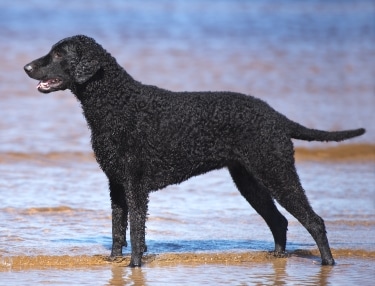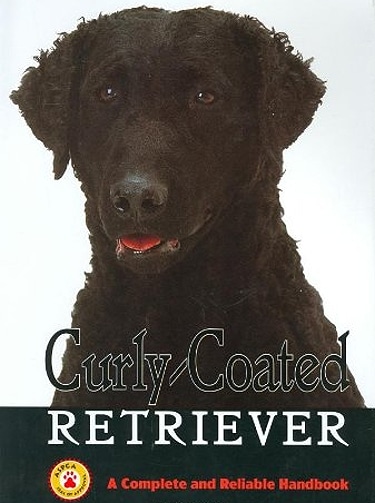
The Curly Coated Retriever was developed in England and is one of the oldest retriever breeds. It is believed to have descended from the 16th century English Water Spaniel, the Irish Water Spaniel and a small Newfoundland type dog. In the 19th century, the breed was then crossed with the Poodle. By the mid 1800s, the Curly Coated Retriever was one of the most popular breeds in England.
The breed was first exhibited at England’s Birmingham show in the mid-19th century. By the end of the 1800s, Curlies were sent to Australia and New Zealand where they also became quite popular.
In the 1900s, it is believed the popularity of the Curly Coated Retrievers was diminished due to word which spread that several atypical Curlies were labeled as a hard-mouthed retriever. This tarnished the breed’s reputation and caused some hunters to choose different retrievers. The truth is that Curlies are actually quite a tender-mouthed retriever.
The Curly Coated Retriever is a large, muscular, athletic dog known to be graceful and elegant. Its stance exudes confidence, agility, strength. Its distinctive water resistant curly coat protects the breed from the elements, particularly from icy waters. Curly Coated Retrievers have muscular limbs, a longer body than its height, small ears and a clean cut tapered head.
Curly Coated Retrievers have the strength and endurance to work long days – they are eager to retrieve as long as there is work to be done. To endure a long day of endless retrieving, Curly Coated Retrievers must be in excellent shape – they must be strong, agile, robust and balanced.
The Curly Coated Retriever was first brought to the United States in 1907 and the breed was recognized by the AKC in 1924. Curly Coated Retrievers are one of the breeds which almost didn’t survive both WWI and WWII.
Height: The height for a Curly Coated Retriever is between 25-27 inches (63-69 cm)
Weight: The weight for a Curly Coated Retriever is between 65-80 pounds (29-36 kg)
Coat Type: The Curly-Coated Retriever’s coat is a distinguishing characteristic of the breed. There is no undercoat and curls are small and tight and protect the breed from harsh elements. Curls also completely cover the ears, neck, thighs, rear legs at least to the hock and the tail. On the face, front of forelegs and feet, the coat is smooth and short. Curly Coated Retrievers don’t shed as much as other breeds and shedding typically is seasonal. The coat is easy to care for.
Color: The Curly Coated Retriever’s coat is black or liver. A prominent white patch on breast is undesirable, but a few white hairs allowable in an otherwise good dog.
Temperament: Curly Coated Retrievers are happy, energetic, very intelligent and they make a great family dog. Easy to train; love to be outdoors, love to swim. Curly Coated Retrievers are known to be great hunters. These dogs are late bloomers and do not fully mature until they are about 3 years old. Curly Coated Retrievers can be stubborn
Health Problems: Curlies are susceptible to these heath problems: joint and bone problems, eye diseases, epilepsy, bloat, Glycogen Storage Disease (GSD) and cancer. Average life expectancy for a Curly Coated Retriever is 9 – 14 years.
Special Interest:
• The Curly-Coated Retriever is considered to be one of the oldest retriever breeds.
• The first breed club for the Curly-Coated Retriever was formed in England in 1896.
• Curly Coated Retrievers are often referred to as a Curly or Curlies for plural.
• Curly Coated Retrievers are the tallest of the retrievers.
• Curlies were first recognized by the AKC in 1924.
Classifications:
AKC: Sporting Group
ANKC: Group 3 – Gun Dogs
CKC: Retriever
FCI: Group 8 Section 1 – Retrievers
KC: Gun Dog Group
UKC: Gun Dog Group
Kennel.com Recommends Curly Coated Retriever
Curly Coated Retriever
 Kennel.com – Complete Guide to Dogs The Dog Lovers Guide
Kennel.com – Complete Guide to Dogs The Dog Lovers Guide